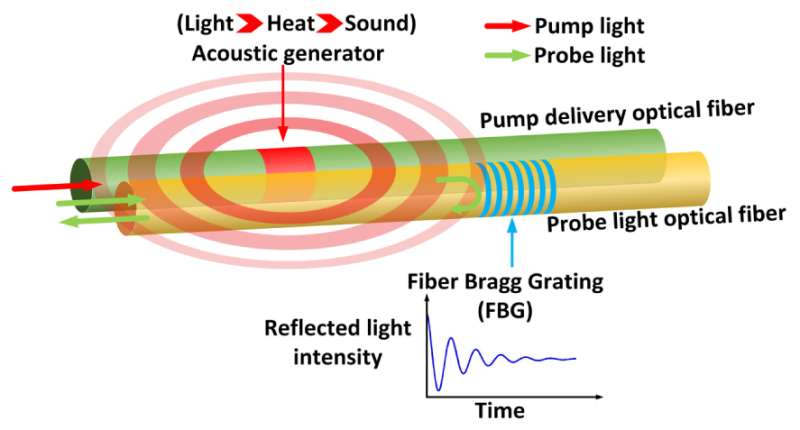New all fiber-optic system for monitoring structural integrity in harsh environments

Structural health monitoring systems traditionally use piezoelectric transducers—a device which converts pressure to electric voltage. These transducers normally have excellent reliability except in cases of corrosive environments or under high temperatures, above 300° Celsius. Their accuracy and usefulness are limited in these harsh environments.
Now a new fiber-optics technology developed by researchers at The Center for Photonics Technology at Virginia Tech, Blacksburg, Virginia, USA, promises to improve the ability to monitor structures under extreme conditions. Specifically, the new system is designed to sense factors such as the strain, temperature and deformation in structures, as well as the appearance of cracks.
"Fiber optic components have been demonstrated to work reliably under very high temperatures because of the simplicity of the optical fiber material—fused silica—that forms the fiber," explained graduate student Chennan Hu and first author of the new paper. "The development of this fiber-optics technology would significantly enhance the monitoring of the health conditions of critical infrastructures operating under harsh environments, such as modern superheaters or nuclear power plants. It will thus help ensure the continuous operation of power plants and help prevent the catastrophic consequences of possible structural failures."
Along with Hu, the paper is also coauthored by Zhihao Yu, a postdoctoral researcher, and Anbo Wang, the Center's director. The technology is described in the journal Optics Express, from The Optical Society (OSA).
The system uses two optical fibers to serially connect multiple active fiber-optic non-destructive evaluation elements (or active FO-NDE elements) that are attached to the surface of the structure being monitored. Each sensing element consists of an acoustic-generation unit, located within a fiber-optic cable, and an acoustic-detection unit, also within a fiber-optic housing.
When excited by a fiber-transmitted laser pulse, the acoustic-generation unit produces acoustic vibrations—sound waves—that propagate in the structure. These vibrations are received by the acoustic-detection unit, a device called a Fiber Bragg grating (FBG), which forms the acoustic signature of the structure. In addition, the FBG also provides information about the strain and temperature of the structure.
"By analyzing the acoustic signature of the structure and the additional information from FBG, we can simultaneously monitor multiple environment parameters," Hu said. This builds upon research previously published in Optics Express, 17.22 (2009).
In the research described in the paper, changes in temperature, strain and thickness, and the appearance of an artificially generated crack, were monitored in a piece of aluminum. The paper did not demonstrate monitoring under high temperatures, "but we believe that this system could be used in high temperature when the low-temperature epoxy is replaced by high temperature adhesive, and we have already acquired promising high-temperature monitoring results," Hu said.
The researchers say that one possible application of the distributed sensing system would be on the outer surface of so-called P91 pipes, which are widely used in the power industry.
"These pipes are usually used to transmit corrosive high-temperature, high-pressure steam," Hu explained. "However, the integrity of these pipes and other critical materials involved in a power-generation system may deteriorate over time and the deterioration rate may pick up rapidly as the system operating temperature is pushed higher, so monitoring of these materials becomes more important."
The sensor system also could be used on an aircraft to monitor the health of multiple points in the gas turbine engine or other critical parts, the researchers said.
Next, the team plans to develop a compact and robust sensor system and field-test the system in a real power plant, then adapt their technology for commercial use, Hu explained.
More information: Chennan Hu et al. An all fiber-optic multi-parameter structure health monitoring system, Optics Express (2016). DOI: 10.1364/OE.24.020287
Yuhua Li et al. Fiber Bragg gratings with enhanced thermal stability by residual stress relaxation, Optics Express (2009). DOI: 10.1364/OE.17.019785
Journal information: Optics Express
Provided by Optical Society of America



















